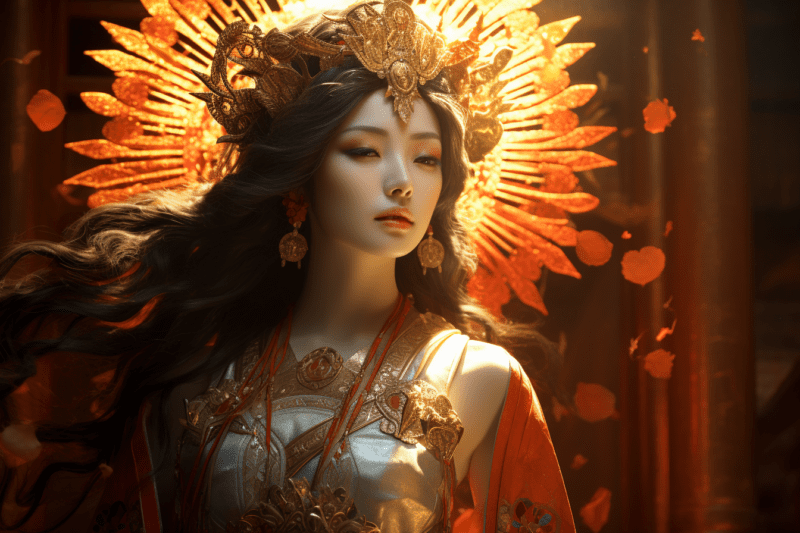In the realm of Hawaiian mythology, Pele, the goddess of fire, lightning, wind, and volcanoes, holds a position of immense reverence and awe. Known for her fiery temperament and creative prowess, Pele has captivated the hearts and minds of both locals and visitors alike. In this blog article, we delve into the captivating world of Pele, exploring her origins, her significance in Hawaiian culture, and the legends that surround her. Join us on this mesmerizing journey as we unravel the power and grace of the Hawaiian goddess, Pele.
Origins of Pele:
Pele’s origins can be traced back to the ancient Polynesians who migrated to the Hawaiian Islands. Born from the union of Haumea (the Earth goddess) and Kane Milohai (the creator god), Pele emerged as a powerful and fiery deity. According to legend, she fled her father’s exile and traveled across the Pacific on a life-changing journey before settling on Hawaii’s magnificent volcanoes.
Significance in Hawaiian Culture:
Pele holds immense significance in Hawaiian culture, as she is considered the creator and caretaker of the islands. Revered as both a benefactor and a destroyer, Pele embodies the volatile yet life-giving forces of nature. Hawaiians honor her with rituals, chants, and offerings, seeking her protection and guidance. Volcanic eruptions are seen as manifestations of Pele’s presence and power, reminding the people of her eternal influence.
Legends Surrounding Pele:
Pele’s compelling mythology is woven into the fabric of Hawaiian folklore. One popular legend tells the story of Pele’s rivalry with her sister, the goddess of the sea. Volcanic eruptions and the ocean’s ferocious clash stand in for the ongoing conflict between fire and water. Other tales narrate Pele’s romantic escapades and her encounters with mortals, highlighting her passion, jealousy, and love for the land she governs.
Symbols and Representations:
Pele is associated with various symbols and representations that embody her divine essence. The volcano, particularly Kilauea, is considered her earthly manifestation, and its eruptions are seen as her fiery breath. Other symbols include the red-hot lava, the ohelo berry, and the hala tree. These symbols are used in art, crafts, and storytelling to depict Pele’s presence and convey her power and influence.
Pele’s Modern-Day Legacy:
Pele’s legacy continues to thrive in modern-day Hawaii. Visitors flock to the awe-inspiring volcanic landscapes, paying homage to the goddess and seeking her blessings. The concept of Pele extends beyond mythology, with her name gracing businesses, cultural events, and even sports teams. As a symbol of resilience, creativity, and fiery determination, Pele’s influence permeates all aspects of Hawaiian life.
Pele, the Hawaiian goddess of fire, lightning, wind, and volcanoes, stands as a captivating figure in Hawaiian mythology. Her origins are rooted in ancient Polynesian beliefs, and her significance is deeply ingrained in Hawaiian culture. Pele’s power and grace continue to inspire awe and reverence. The legends that surround her portray a complex deity, embodying both creative energy and destructive force. Her symbols and representations serve as visual reminders of her divine presence, while her modern-day legacy reflects her enduring influence on the Hawaiian Islands.
As visitors venture to the volcanic landscapes of Hawaii, they are met with a palpable connection to Pele. The sight of Kilauea, her earthly manifestation, evokes a sense of wonder and respect. The fiery eruptions of the volcano are seen as Pele’s breath, a reminder of her constant presence and power. Locals and visitors alike partake in rituals and offerings to honor the goddess, seeking her protection and guidance in their lives.
Pele’s mythology is woven into the tapestry of Hawaiian folklore, enriching the cultural heritage of the islands. One popular legend recounts her rivalry with her sister, the goddess of the sea, representing the eternal struggle between fire and water. These tales demonstrate the depth of Pele’s emotions, showcasing her passion, jealousy, and unwavering love for the land she governs.
Symbols associated with Pele hold profound meaning in Hawaiian art and storytelling. The red-hot lava represents her fiery essence, while the ohelo berry and hala tree symbolize her connection to the land and its resources. These symbols find their way into various forms of artistic expression, from paintings and sculptures to traditional crafts and jewelry, showcasing Pele’s enduring influence on Hawaiian aesthetics.
Beyond mythology, Pele’s legacy extends into modern-day Hawaii. Her name adorns businesses, cultural events, and sports teams, serving as a testament to her enduring significance. The spirit of Pele, characterized by resilience, creativity, and unwavering determination, resonates within the hearts of the Hawaiian people. Her story serves as a reminder of the profound bond between nature and human existence, urging us to cherish and protect the land we inhabit.
In conclusion, Pele, the Hawaiian goddess of fire, lightning, wind, and volcanoes, holds a significant place in Hawaiian culture and mythology. Her origins, legends, symbols, and modern-day legacy contribute to a captivating narrative that continues to inspire and enchant. As we explore the power and grace of Pele, we gain a deeper appreciation for the natural forces that shape our world and the timeless wisdom embedded in ancient myths. Let us embrace the spirit of Pele, honoring the delicate balance between creation and destruction and cherishing the lands we call home.





